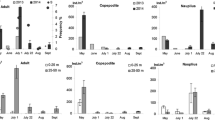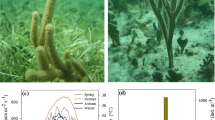Summary
Seasonal patterns of lipid reserves and lipid classes of dominant zooplankton in a hyper-eutrophic lake were examined in relation to algal food resources. Triacylglycerol was the principle lipid energy reserve in all five species examined. During the height of the yearlyAphanizomenon flos-aquae bloom, lipid levels of the principle herbivores (Daphnia pulex andLeptodiaptomus sicilis) and an omnivore (Diacyclops bicuspidatus thomasi), were at their lowest concentration, suggesting that this cyanobacterium is nutritionally inadequate. As the cyanobacterial bloom began to collapse, bacterial numbers increased rapidly. The increase in bacterial numbers coincided with a large increase in areal lipid energy reserves ofDiaphanosoma leuchtenbergianum andChydorus sphaericus. Examination of seasonal patterns in the biomass of different algal species suggested thatRhodomonas minuta andCryptomonas erosa played a key role in nutrition, lipid deposition, and reproduction ofD. pulex andL. sicilis.
Similar content being viewed by others
References
Ahlgren G, L Lundstedt, M Brett and C Forsberg (1990) Lipid composition and food quality of some freshwater phytoplankton for cladoceran zooplankters. J Plankton Res 12:809–818
Arts MT, WG Sprules (1987) Energy reserves of three zooplankton species from two lakes with different metal concentrations. Can J Fish Aquat Sci 44:458–466
Arts MT, MS Evans (1991) Optical-digital measurements of energy reserves in calanoid copepods: Intersegmental distribution and seasonal patterns. Limnol Oceanogr 36:289–298
A.P.H.A. (1989) Standard methods for the examination of water and wastewater. American Public Health Association. (17th ed) 4:137–139
Bourdier GG, CA Amblard (1989) Lipids inAcanthodiaptomus denticornis during starvation and fed on three different algae. J Plankton Res 11:1201–1212
Chow-Fraser P (1985) Herbivorous feeding of zooplankton in lakes of south central Ontario. Ph.D. thesis University of Toronto. Toronto 96 pp
Clarke A, C Ellis-Evans, MW Sanders, LJ Holmes (1989) Patterns of energy storage inPseudoboeckella poppei (Crustacea, Copepoda) from two contrasting lakes on Signy Island, Antarctica. Hydrobiol 172:183–191
Coveney MF, G Cronberg, M Enell, K Larson, L Olofsson (1977) Phytoplankton, zooplankton and bacteria-standing crop and production relationships in a eutrophic lake. Oikos 29:5–21
DeMott WR (1986) The role of taste in food selection by freshwater zooplankton. Oecologia 69:334–340
DeMott WR, F Moxter (1991) Foraging on cyanobacteria by copepods: responses to chemical defenses and resource abundance. Ecology 72:1820–1834
Earle JC, HC Duthie, DA Scruton (1987) Factors influencing the distribution of phytoplankton in 97 headwater lakes in insular Newfoundland. Can J Fish Aquat Sci 44:639–649
Environment Canada (1979) Analytical Methods Manual. Inland Waters Directorate, Water Quality Branch, Environment Canada, Ottawa, Canada
Folch J, M Lees, GHS Stanley (1957) A simple method for the isolation and purification of total lipids from animal tissues. J Biol Chem 226:497–509
Gardner WS, WA Frez, EA Cichocki, CC Parrish (1985) Micromethod for lipids in aquatic invertebrates. Limnol Oceanogr 30:1099–1105
Geller W, H Müller (1981) The filtration apparatus of Cladocera: Filter mesh-sizes and their implications on food selectivity. Oecologia 49:316–321
Goulden CE, AR Place (1990) Fatty acid synthesis and accumulation rates in Daphnids. J Exp Zool 256:168–178
G.-Toth L, NP Zánkai, OM Messner (1987) Alga consumption of four dominant planktonic crustanceans in Lake Balaton (Hungary). Hydrobiol 145:323–332
Håkanson JL (1987) The feeding condition ofCalanus pacificus and other zooplankton in relation to phytoplankton pigments in the California Current. Limnol Oceanogr 32:881–894
Hama T, K Matsunaga, N Handa, M Takahashi (1990) Composition of photosynthetic products in Lake Biwa, Japan; vertical and seasonal changes and their relation to environmental factors. J Plankton Res 12:133–147
Hammer UT (1978) The saline lakes of Saskatchewan. III. Chemical characterization. Int revue ges Hydrobiol 63:311–335
Hammer UT, RC Haynes (1978) The saline lakes of Saskatchewan. II. Locale, hydrography, and other physical aspects. Int Revue Ges Hydrobiol 63:179–203
Hammer UT, J Shamess, RC Haynes (1983) The distribution and abundance of algae in saline lakes of Saskatchewan, Canada. Hydrobiol 105:1–26
Haynes RC, UT Hammer (1978) The saline lakes of Saskatchewan. IV. Primary production by phytoplankton in selected saline ecosystems. Int Revue Ges Hydrobiol 63:337–351
Holm NP, GG Ganf, J Shapiro (1983) Feeding and assimilation rates forDaphnia pulex fedAphanizomenon flo-aquae. Limnol Oceanogr 28:677–687
Holm NP, J Shapiro (1984) An examination of lipid reserves and the nutritional status ofDaphnia pulex fedAphanizomenon flosaquae. Limnol Oceanogr 29:1137–1140
Knisely K, W Geller (1986) Selective feeding of four zooplankton species in natural phytoplankton. Oecologia 69:86–94
Kuosa H, G Gyllenberg (1989) Lipid content and utilization of lipids in planktonic copepods in Lake Pääjärvi, southern Finland. Hydrobiol 171:215–222
Lampert W (1987) Feeding and nutrition inDaphnia. In Peters RH, R de Bernardi (eds.) “Daphnia” Mem Ist Ital Idrobiol 45:143–192
Lundstedt L, MT Brett (1991) Differential growth rates of three cladoceran species in response to mono- and mixed-algal cultures. Limnol Oceanogr 36:159–165
Lynch M (1980)Aphanizomenon blooms: Alternate control and cultivation byDaphnia pulex. In Kerfoot WC (ed.) “Evolution and ecology of zooplankton communities” University Press of New England, Hanover, New Hampshire pp. 299–304
McNaught DC, D Griesmer, M Kennedy (1980) Resource characteristics modifying selective grazing by copepods. In WC Kerfoot (ed.) “Evolution and ecology of zooplankton communities” University Press of New England, Hanover pp. 292–298
McQueen DJ (1969) Reduction of zooplankton standing stocks by predaciousCyclops bicuspidatus thomasi in Marion Lake, British Columbia. J Fish Res Bd Can 26:1605–1618
Nusch EA (1980) Comparison of different methods for chlorophyll and phaeopigment determination. Arch Hydrobiol Beih Ergebn Limnol 14:14–36
Parrish CC (1987) Separation of aquatic lipid classes by chromarod thin-layer chromatography with measurement by Iatroscan flame ionization detection. Can J Fish Aquat Sci 44:722–731
Porter KG (1973) Selective grazing and differential digestion of algae by zooplankton. Nature 244:179–180
Rawson DS, JE Moore (1944) The saline lakes of Saskatchewan. Can J Res D 22:141–201
Robarts RD, LM Sephton (1981) The enumeration of aquatic bacteria using DAPI. J Limnol Soc sth Afr 7:72–74
Robarts RD, RJ Wicks (1989) [Methyl-3H]thymidine macromolecular incorporation and lipid labelling: Their significance to DNA labelling during measurments of aquatic bacterial growth rate. Limnol Oceanogr 34:213–222
Roberts JR, ASW DeFrietas, MAJ Gidney (1977) Influence of lipid pool size on bioaccumulation of the insecticide Chlordane by northern redhorse suckers (Moxostoma macrolepidotum). J Fish Res Bd Can 34:89–97
Roman MR (1991) Pathways of carbon incorporation in marine copepods: Effects of developmental stage and food quantity. Limnol Oceanogr 36:796–807
Ross PE, M Munawar (1981) Preference for nanoplankton size fractions in Lake Ontario zooplankton grazing. J Great Lakes Res 7:65–67
Sargent JR, S Falk-Peterson (1981) Ecological investigations on the zooplankton community in Balsfjorden, northern Norway: Lipids and fatty acids inMeganyctiphanes norvegica, Thysanoessa raschi andT. inermis during mid-winter. Mar Biol 62:131–137
Sargent JR, RJ Henderson (1986) Lipids. In Corner EDS and SCM O'Hara (eds.) “The biological chemistry of marine copepods”. Clarendon Press, Oxford pp. 61–108
Sterner RW (1989) Resource competition during seasonal succession toward dominance by cyanobacteria. Ecology 70:229–245
Stewart AJ, RG Wetzel (1989) Cryptophytes and other microflagellates as couplers in planktonic community dynamics. Arch Hydrobiol 106:1–19
STSC (1989) Statgraphics-Statistical Graphics Corporation. Ver. 4.0. Rockville, MD, USA
Tessier AJ, CE Goulden (1982) Estimating food limitation in cladoceran populations. Limnol Oceanogr 27:707–717
Timms BV, UT Hammer, JW Sheard (1986) A study of benthic communities in some saline lakes in Saskatchewan and Alberta, Canada. Int Revue ges Hydrobiol 71:759–777
U.S.G.S. (1985) Methods for determination of inorganic substances in water and fluvial sediments. In “Techniques of water resources investigations of the United States Geological Survey”, Book 5 pp. 419–424
Vanderploeg, HA (1981) Seasonal particle-size selection byDiaptomus sicilis in offshore Lake Michigan. Can J Fish Aquat Sci 38:504–517
Vanderploeg HW, WS Gardner, CC Parrish, JR Liebig, JF Cavaletto (1992) Lipids and lifecycle strategy of a hypolimnetic copepod in Lake Michigan. Limnol Oceanogr 37(3) (in press)
Wainman BC, DRS Lean (1990) Seasonal trends in planktonic lipid content and lipid class. Verh Internat Verein Limnol 24:416–419
Wetzel RG (1975) Limnology. W. B. Saunders Company, Philadelphia p 743
Wrench JJ, RF Addison (1981) Reduction, methylation, and incorporation of arsenic into lipids by the marine phytoplanktonDunaliella tertiolecta. Can J Fish Aquat Sci 38:518–523
Author information
Authors and Affiliations
Rights and permissions
About this article
Cite this article
Arts, M.T., Evans, M.S. & Robarts, R.D. Seasonal patterns of total and energy reserve lipids of dominant zooplanktonic crustaceans from a hyper-eutrophic lake. Oecologia 90, 560–571 (1992). https://doi.org/10.1007/BF01875451
Received:
Accepted:
Issue Date:
DOI: https://doi.org/10.1007/BF01875451




